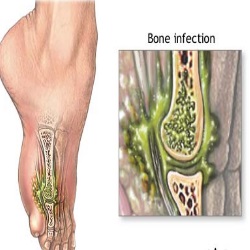 Osteomyelitis is a kind of infection of the bone, which is often caused by bacteria named staphylococcus.
Osteomyelitis is a kind of infection of the bone, which is often caused by bacteria named staphylococcus.
These bacteria can infect bone by spreading from the nearby tissues or travelling through the bloodstream from other parts of the body that have been infected or from an open wound, fracture or cut that gets exposed to bone and lead to osteomyelitis.
Causes Of Osteomyelitis
Osteomyelits is rare but the condition can affect both adults and children in different ways. Children most often get osteomyelitis in long bones like legs or upper arms while in adults, it may affect bones of the spine (vertebrae). A person’s chances of contracting this condition increases when his/her immune system gets weak due to diabetes, HIV or AIDS, rheumatoid arthritis, alcoholism, drug use, sickle cell disease or prolonged use of steroids. Germs commonly found in the nose or skin of even a healthy individual can make its way through the following ways:
Through The Bloodstream
Source: http://drbcshah.com/urinary-tract-infection/
Due to some infections or diseases like urinary tract infection (UTI) or pneumonia, the germs existing in other parts of the body can travel through the bloodstream to the susceptible area of the bone, where you have injury, cut or fracture.
From Infection In The Nearby Tissue
Open cuts and wounds can get infected and carry germs to the nearby bones, leading to the development of Osteomyelitis.
Direct Contamination
Direct contamination is possible when you have severe bone fractures. Surgery of the broken bone or joint replacement can also accidentally open the way for the germs to enter the bone. Similarly, deep animal bites can allow germs to enter the bone as well.
Circulation Disorders
The blocked or damaged blood vessels cannot distribute infection-fighting cells that are required for restricting small infections from spreading or growing bigger. Often small cuts in this condition can turn into deep ulcers and expose the bone or tissue to severe infection.
Source: http://www.healingfeet.com/blog/foot-care/feet-dont-lie-peripheral-arterial-disease
Such conditions include peripheral arterial disease, poorly controlled Diabetes and sickle cell disease. For instance, people with diabetes have the risk of developing osteomyelitis in their feet when they are suffering from foot ulcers.
Diseases That Require Intravenous Catheters Or Lines
Some medical conditions require use of medical tubing for connecting the internal organs. This tubing increases the risk of germs getting into the body and sometimes leads to osteomyelitis. Urinary catheters, dialysis machine etc. are some of the examples of this type of tubing.
Conditions That Weaken The Immune System
Some medical conditions or medications affect the immune system and increase the risk for osteomyelitis. Chemotherapy, organ transplant and uncontrolled diabetes are such medical conditions that badly damage the immune system and make one vulnerable to infection.
Intravenous Drug Use
People who inject illicit drugs using non-sterile needles can have increased chances of developing osteomyelitis.
Symptoms Of Osteomyelitis
A person having osteomyelitis may have pain, swelling, tenderness, redness and warmth around the infected bone. There can be symptoms like fever and chills and the infected person or child feels lethargy, irritability and nauseous. The infected person may also lose range of motion. Osteomyelitis in the spine may have symptoms like severe back pain at night.
But sometimes ostomyelitis displays no symptoms at all or shows symptoms that are difficult to distinguish from other problems, due to which the infection develops rapidly. The first step for treating osteomyelitis is figuring out whether the person is actually suffering from osteomyelitis, which is often very difficult. If you are experiencing worsening bone pains accompanied with fever, or have undergone surgery recently, see your doctor without any delay with the slightest sign of infection.
Photo Credit: http://www.rapidmed.net/Osteomyelitis.html
Caution: Please use Home Remedies after Proper Research and Guidance. You accept that you are following any advice at your own risk and will properly research or consult healthcare professional.




